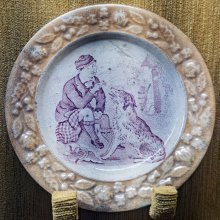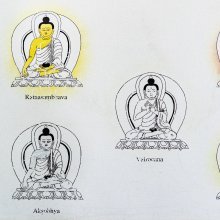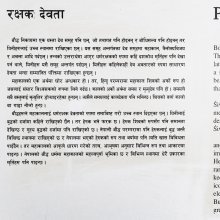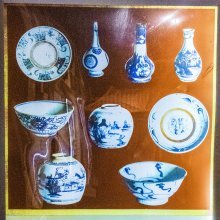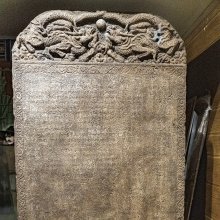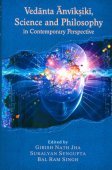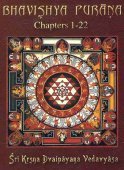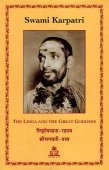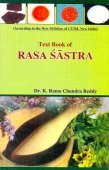Varna, Varṇā, Varṇa: 58 definitions
Introduction:
Varna means something in Buddhism, Pali, Hinduism, Sanskrit, Jainism, Prakrit, the history of ancient India, Marathi, Hindi. If you want to know the exact meaning, history, etymology or English translation of this term then check out the descriptions on this page. Add your comment or reference to a book if you want to contribute to this summary article.
Images (photo gallery)
In Hinduism
Ayurveda (science of life)
Rasashastra (Alchemy and Herbo-Mineral preparations)
Source: Indian Journal of History of Science, 31(4), 1996: MūṣāvijñānaVarṇa (वर्ण) or Varṇamūṣā refers to an “dyeing crucible” and is a type of mūṣā (crucible) used for smelting metals.—Varṇa-mūṣā was again a special kind of crucible which was made of red-coloured earth, juices of red-medicinal herbs such as Mañjiṣṭha (Rubia cordifolio, Linn.), flower of Kusumbha (Carthamus tictorus, Linn.), lac, essences of cochineal and earthworms. This crucible acquired a red colour and bestowed excellent colour to the calx of mercury or other metals, which were roasted in it. Also see Rasaratnasamuccaya 10.17.
Agriculture (Krishi) and Vrikshayurveda (study of Plant life)
Source: Shodhganga: Drumavichitrikarnam—Plant mutagenesis in ancient IndiaVarṇa (वर्ण) refers to the “colour (of plants)” which can be modified according to the bio-organic agricultural methods described in the Vṛkṣāyurveda by Sūrapāla (1000 CE): an encyclopedic work dealing with the study of trees and the principles of ancient Indian agriculture.—Accordingly, “Several special processes with reference to the plants will be described hereunder. They are: [e.g., changing the colours (varṇa-pravartana);] and so on. [...]”.
Veterinary Medicine (The study and treatment of Animals)
Source: archive.org: The Elephant Lore of the HindusVarṇa (वर्ण) refers to the “color” (of an elephant), according to the 15th century Mātaṅgalīlā composed by Nīlakaṇṭha in 263 Sanskrit verses, dealing with elephantology in ancient India, focusing on the science of management and treatment of elephants.—[Cf. chapter 8, “on marks of character”]: “15. The colors (varṇa) of elephants are fourfold: tawny, yellow, black, and white [haripītakāladhavalā varṇāścaturdhā]; respectively from blood mingled with gall, from blood mingled with phlegm, from gall, and from phlegm they are produced, be it known, like unto (a peacock’s) tail feathers, to gold, to a cloud, and to moonlight. But among these that black one alone exists here on earth; the other three are in the heavenly world”.
Unclassified Ayurveda definitions
Source: Wisdom Library: Āyurveda and botanyVarṇa (वर्ण) is a Sanskrit technical term, translating to the “color” of a plant. It is used throughout Ayurvedic literature such as the Suśruta-saṃhitā and the Caraka-saṃhitā.
Source: gurumukhi.ru: Ayurveda glossary of termsVarṇa (वर्ण):—1. Colour 2. Complexion; an action attributed to Agni Mahabhuta

Āyurveda (आयुर्वेद, ayurveda) is a branch of Indian science dealing with medicine, herbalism, taxology, anatomy, surgery, alchemy and related topics. Traditional practice of Āyurveda in ancient India dates back to at least the first millenium BC. Literature is commonly written in Sanskrit using various poetic metres.
Dharmashastra (religious law)
Source: Wisdom Library: Dharma-śāstraVarṇa (वर्ण) refers to “colour”, as in, a visible trait or charecteristic of a human being. When a King (rājan) is investigating a suit in the court, he is to closely watch the variations (ākāra) of the subject. For the colour (varṇa) of a person, this means monitoring for sudden changes of complexion etc. The term is used throughout Dharmaśāstra literature such as the Manusmṛti.
Source: Sacred Texts: The Grihya Sutras, Part 2 (SBE30)Varṇa (वर्ण) refers to “colour” or “caste”.—The four castes, with the Śūdra as the fourth, are mentioned once in the Ṛg-veda, X, 90, 12. The opposition between Āryas and Śūdras occurs in the Atharva-veda, XIX, 62, &c., and in most of the Brāhmaṇas. In the Śatapatha Brāhmaṇa we read of the four castes, Brāhmaṇa, Rājanya, Vaiśya, and Śūdra, and we are told that none of them vomits the Soma.
Source: Shodhganga: The saurapurana - a critical study (dharma)Varṇa (वर्ण) refers to the “four castes” of ancient India, according to the 10th century Saurapurāṇa: one of the various Upapurāṇas depicting Śaivism.—In ancient India the society was divided into four principal castes, namely Brāhmaṇa, Kṣatriya, Vaiśya and Śūdra; and the dharmaśāstras employ the term varṇa to designate these castes. Though the word varṇa literally means “colour”, it can’t be held that the four castes mentioned in the Sūtra literature were distinguished from each other by the colour of their skin.

Dharmashastra (धर्मशास्त्र, dharmaśāstra) contains the instructions (shastra) regarding religious conduct of livelihood (dharma), ceremonies, jurisprudence (study of law) and more. It is categorized as smriti, an important and authoritative selection of books dealing with the Hindu lifestyle.
Natyashastra (theatrics and dramaturgy)
Source: Wisdom Library: Nāṭya-śāstra1) Varṇa (वर्ण) refers to “pitch of vowels”. According to the Nāṭyaśāstra, it is part of the ‘vocal representation’ (vācika), which is used in communicating the meaning of the drama and calling forth the sentiment (rasa).
2) Varṇa (वर्ण) is a Sanskrit word referring to the four castes (e.g., Brāhmaṇa, Kṣatriya, Vaiśya and Śūdra). Acording to the Nāṭyaśāstra 1.82-88, when Brahmā, Indra and all other gods went to inspect the playhouse (nāṭyamaṇḍapa) designed by Viśvakarmā, he assigned different deities for the protection of the playhouse itself, as well as for the objects relating to dramatic performance (prayoga).
As such, Brahmā assigned Varṇa (as deities) to the pillars (stambha). The protection of the playhouse was enacted because of the jealous Vighnas (malevolent spirits), who began to create terror for the actors.
3) Varṇa (वर्ण, “color”).—There are original (natural) colors, according to Nāṭyaśāstra chapter 23.
The four colors are:
- sita (white),
- nīla (blue),
- pīta (yellow),
- rakta (red).
Besides these, there are also many derivative and minor colors (upavarṇa).
4) Varṇa (वर्ण) refers to the production of notes in a particular way, according to the Nāṭyaśāstra chapter 29. The varṇas are used to make up the alaṃkāras (embellishments) of a song.
There are four varṇas defined:
- ārohin (ascending),
- avarohin (descending),
- sthāyin (lit. ‘staying’; monotonic),
- saṃcārin (lit. ‘moving together’; mixed).
According to the Nāṭyaśāstra, “these four varṇas having clearly defined aspects, are taken (lit. born of) from the human (lit. physical) voice and they relate to the quality of the three voice registers (sthāna). When a regular (lit. having a characteristic) song (pada) adds at least two varṇas to it, then the varṇas give rise to sentiments (rasa)”.
Source: Google Books: Studies in the NāṭyaśāstraVarṇa (वर्ण, “accent”).—Abhinava explains that they are svaradharmas, i.e., ‘qualities of sound’. They are so called because they make clear the special meaning. They are udātta (acute), anudātta (grave), svarita (circumflex) and kampita (quivering). Svarita and udātta are to be used in the Comic and the Erotic; udātta and kampita in the Heroic, the Furious and the Marvellous; and anudātta, svarita, and kampita in the Pathetic, the Odious and the Terrifble.
Source: Academia.edu: The Nāṭyaśāstra: the Origin of the Ancient Indian PoeticsThe four kinds of pronunciation (varṇa) were divided into the high (udātta), low (anudātta), melodic (svarita) and vibrant (kampita) ones.

Natyashastra (नाट्यशास्त्र, nāṭyaśāstra) refers to both the ancient Indian tradition (shastra) of performing arts, (natya—theatrics, drama, dance, music), as well as the name of a Sanskrit work dealing with these subjects. It also teaches the rules for composing Dramatic plays (nataka), construction and performance of Theater, and Poetic works (kavya).
Purana and Itihasa (epic history)
Source: Wisdom Library: Varāha-purāṇaVarṇā (वर्णा).—One of the seven major rivers in Kuśadvīpa, according to the Varāhapurāṇa chapter 87. It is also known by the name Vibhāvarī. Kuśadvīpa is one of the seven islands (dvīpa), ruled over by Vapuṣmān, one of the ten sons of Priyavrata, son of Svāyambhuva Manu, who was created by Brahmā, who was in turn created by Nārāyaṇa, the unknowable all-pervasive primordial being.
The Varāhapurāṇa is categorised as a Mahāpurāṇa, and was originally composed of 24,000 metrical verses, possibly originating from before the 10th century. It is composed of two parts and Sūta is the main narrator.
Source: archive.org: Puranic EncyclopediaVarṇa (वर्ण).—Caste. The four castes of Brāhmaṇa, Kṣatriya, Vaiśya and Śūdra and the eleven castes produced by the intermingling of these four castes, only these are taken into account when we speak of Varṇa. To understand about the four castes of Brāhmaṇa, Kṣatriya, Vaiśya and Śūdra, see under Cāturvarṇya.
To know about the eleven mixed castes that originated from the four castes, see under Ekādaśasaṅkara Varṇas.
Source: archive.org: Shiva Purana - English Translation1) Varṇa (वर्ण) refers to “(four) castes” (born from Brahmā), according to the Śivapurāṇa 2.5.5 (“The Tripuras are fascinated).—Accordingly, as Arihan said to the Lord of the Three Cities: “[...] It is unnecessary to divide the people into different castes. When all are men who is superior and who is inferior? [...] Some of the ancestors thought that the four castes are born of mouth, arms, thighs etc. of Brahmā. But when we consider, this does not fit in properly. How can sons born of the same body or from the same body be of four different castes (bhinna-varṇa)? Hence the divisions of castes and outcastes do not appear to be sound. Hence no difference between man and man should be entertained. [...]”.
2) Varṇa (वर्ण) refers to the “syllables” (of mantras), according to the Śivapurāṇa 2.5.8 (“The detailed description of the chariot etc.”).—Accordingly, as Sanatkumāra narrated to Vyāsa: “The divine chariot of lord Śiva consisting of all the worlds was built by Viśvakarman with devoted effort. [...] The forceful and excellent mantras with their syllables (varṇa) and feet (pāda), of all characteristic features and the stages in life constituted the tinkling bells. Ananta embellished with thousand hoods constituted its fittings. and the main and subsidiary quarters, the pedestals of the chariot. [...]”
Source: Cologne Digital Sanskrit Dictionaries: The Purana Index1a) Varṇa (वर्ण).—A Sudharmāna god.*
- * Brahmāṇḍa-purāṇa IV. 1. 60.
1b) The origin of, from the limbs of Nārāyaṇa;1 of Music; four-fold of Gītaka; sthāyivarṇa, prasaṃcāri, avarohaṇam, ārohaṇa; every varṇa has one of four alamkārassthāpani, kramarejina, pramāda and apramāda.2

The Purana (पुराण, purāṇas) refers to Sanskrit literature preserving ancient India’s vast cultural history, including historical legends, religious ceremonies, various arts and sciences. The eighteen mahapuranas total over 400,000 shlokas (metrical couplets) and date to at least several centuries BCE.
Shaktism (Shakta philosophy)
Source: Google Books: Manthanabhairavatantram1) Varṇa (वर्ण) refers to “great phonemic energies”, according to the Bhairavīstotra in the Śrīmatottara-tantra, an expansion of the Kubjikāmatatantra: the earliest popular and most authoritative Tantra of the Kubjikā cult.—Accordingly, “Victory! Victory (to you) O goddess (bhagavatī)! [...] Victory to you who have merged the entire universe into a single vibrant state of oneness filling (thereby every) discontinuity! (You are) beautiful with the necklace that (hangs from your) neck made of the pearls of the great phonemic energies (varṇa)! You who are in the centre of the great wheel of the Six Yoginīs and the great group of six! [...]”.
2) Varṇa (वर्ण) (= Vārāṇasī) is the name of a sacred site, and one of the places visited by the Goddess on her pilgrimage, according to Tantric texts such as the Kubjikāmata-tantra, the earliest popular and most authoritative Tantra of the Kubjikā cult.—Accordingly, “[The Goddess] went to Devīkoṭa, (arriving there) in a moment, and with a powerful look (āloka) (it became a sacred site. Then she went to) Aṭṭahāsa, (so called) because she laughed (there) loudly. (Then she went to) Kolāgiri, Ujjenī, Prayāga, Varṇā (i.e. Vārāṇasī), Viraja, Ekāmra and other (places) and (then on to) another universe”.
The Śrīmatottara says that: “(The goddess) conceived the sacred fields (kṣetra) by means of the mantras of the fields”. However, the goddesses who are said to reside there are not, it seems at first sight, the eight Mothers. There they are as follows: 1) Prayāga—Khecarī, 2) Varuṇā (Vārāṇasī)—Ātmī, 3) Kollāpura—Somā, 4) Aṭṭahāsā—Vahni, 5) Jayantikā—Calinī, 6) Caritrā—Bhānumatyā, 7) Ekāmraka—Mahi, and 8) Devikoṭṭa—Sukṛtā.
3) Varṇa (वर्ण) (Cf. Samāveśa) refers to “letters” according to Abhinava’s Tantrāloka (verse 1.167-170), while quoting his Mālinīvijayottaratantra (verse 2.21-23).—Accordingly, “The three (ways in which impurity is eradicated) was taught by the Supreme Lord in the Mālinīvijayottaratantra in the course of explaining (the forms) of penetration (into the supreme state) (samāveśa). [...] That penetration which takes place by virtue of the utterance of mantra (uccāra), bodily postures (karaṇa), meditation (dhyāna), the letters (varṇa) and the formation of supports (sthānakalpanā) is appropriately said to pertain to the individual soul (āṇava). [...]”.
Source: JSTOR: Tāntric Dīkṣā by Surya KantaVarṇa (वर्ण) or Varṇādhvā refers to one of the six adhvans being purified during the Kriyāvatī-dīkṣā: an important Śākta ritual described Śāradātilaka-tantra, chapters III-V.—“... Looking with the divine eye he transfers the caitanya of his disciple into himself and unites it with that of his own, thereby effecting a purification of the six adhvans namely: kalā, tattva, bhavana, varṇa, pada, and mantra”.
The word adhvā means ‘path’, and when the above six adhvans (viz. varṇa) are purified they lead to Brahman-experience. Dīkṣā is one of the most important rituals of the Śāktas and so called because it imparts divine knowledge and destroys evil.
The varṇas are the mātṛkā letters.

Shakta (शाक्त, śākta) or Shaktism (śāktism) represents a tradition of Hinduism where the Goddess (Devi) is revered and worshipped. Shakta literature includes a range of scriptures, including various Agamas and Tantras, although its roots may be traced back to the Vedas.
Kavya (poetry)
Source: Shodhganga: The Kavyamimamsa of RajasekharaVarṇā (वर्णा) is the name a locality mentioned in Rājaśekhara’s 10th-century Kāvyamīmāṃsā.—In the Kāvyamīmāṃsā, Rājaśekhara described it is the river in south India, its source being the Sahya mountain. It is also identified either with the river Kṛṣnā or Beṇā, which is the branch of the Kṛṣnā or rises from the Western Ghats.

Kavya (काव्य, kavya) refers to Sanskrit poetry, a popular ancient Indian tradition of literature. There have been many Sanskrit poets over the ages, hailing from ancient India and beyond. This topic includes mahakavya, or ‘epic poetry’ and natya, or ‘dramatic poetry’.
Vyakarana (Sanskrit grammar)
Source: Wikisource: A dictionary of Sanskrit grammarVarṇa (वर्ण).—Phonemic unit: a letter The term was in use in ancient times and found used generally in the masculine gender, but occasionally in the neuter gender too; e. g. उपदिष्टा इमे वर्णाः (upadiṣṭā ime varṇāḥ) M. Bh. Ahnika 1. also मा कदाचिदवर्णे भूत् (mā kadācidavarṇe bhūt) M. Bh. on Siva Sutras 3, 4.

Vyakarana (व्याकरण, vyākaraṇa) refers to Sanskrit grammar and represents one of the six additional sciences (vedanga) to be studied along with the Vedas. Vyakarana concerns itself with the rules of Sanskrit grammar and linguistic analysis in order to establish the correct context of words and sentences.
Chandas (prosody, study of Sanskrit metres)
Source: Shodhganga: a concise history of Sanskrit Chanda literatureVarṇa (वर्ण).—The Classical metres are divided into three types viz. 1. vṛtta or varṇa, 2. mātrā or jāti 3. gadya. The metres (chandas) which are calculated through letters are called as varṇa type, and the mātrā type is calculated by syllabic instances. The gadya type of metres are not accepted by all prosodicians, but authorities like Gaṅgādāsa, Candraśekhara, Raghunātha and Gopīnātha advocate for this metre.

Chandas (छन्दस्) refers to Sanskrit prosody and represents one of the six Vedangas (auxiliary disciplines belonging to the study of the Vedas). The science of prosody (chandas-shastra) focusses on the study of the poetic meters such as the commonly known twenty-six metres mentioned by Pingalas.
Jyotisha (astronomy and astrology)
Source: Wisdom Library: Brihat Samhita by Varahamihira1) Varṇa (वर्ण) refers to the “colour” (of the eclipsed lunar disc), according to the Bṛhatsaṃhitā (chapter 2), an encyclopedic Sanskrit work written by Varāhamihira mainly focusing on the science of ancient Indian astronomy astronomy (Jyotiṣa).—Accordingly, “We shall now proceed to give a brief description of (the qualifications of) a jyotiṣaka. [...] He must also know the colour [i.e., varṇa] of the eclipsed lunar disc. He must be able to calculate before hand the times of the Moon’s conjunction with the planets as well as of planetary conjunctions”.
2) Varṇa (वर्ण) refers to the “color” (of the sun and planets), according to the Bṛhatsaṃhitā (chapter 2).—Accordingly, “A true Astrologer is also one who has thoroughly mastered the Science of Saṃhitā. It treats of the motions of the sun and planets; of their size, color [i.e., varṇa], rays, brilliancy and shape and changes in the same of their disappearance and re-appearance; of their courses and deviations therefrom; of their retrograde and reretrograde motions; of their conjunction with the stars and of their places among the stars and the like”.
Source: Wikibooks (hi): Sanskrit Technical TermsVarṇa (वर्ण).—lit., colour. 1. One of the four major divisions of humanity in Hinduism. 2. A way of designating unknown quantities in algebra; different unknowns are referred to by the names of different colours. Note: Varṇa is a Sanskrit technical term used in ancient Indian sciences such as Astronomy, Mathematics and Geometry.

Jyotisha (ज्योतिष, jyotiṣa or jyotish) refers to ‘astronomy’ or “Vedic astrology” and represents the fifth of the six Vedangas (additional sciences to be studied along with the Vedas). Jyotisha concerns itself with the study and prediction of the movements of celestial bodies, in order to calculate the auspicious time for rituals and ceremonies.
Vaishnavism (Vaishava dharma)
Source: Pure Bhakti: Bhagavad-gita (4th edition)Varṇa (वर्ण) refers to “occupational division, or caste, which is ascertained according to one’s nature”. (cf. Glossary page from Śrīmad-Bhagavad-Gītā).
Source: Pure Bhakti: Bhajana-rahasya - 2nd EditionVarṇa (वर्ण) refers to:—Class, occupational division, caste; the four varṇas are: brāhmaṇa, kṣatriya, vaiśya and śūdra. (cf. Glossary page from Bhajana-Rahasya).
Source: Pure Bhakti: Arcana-dipika - 3rd EditionVarṇa (वर्ण) refers to the “four occupational divisions”, according to the Arcana-dīpikā (manual on deity worship).—It is mentioned in various śāstras that a person belonging to any of the four occupational divisions (varṇas) or four stages of life (āśramas) has the right to become a Vaiṣṇava by accepting the viṣṇu-mantras and then engaging in the worship of Śrī Viṣṇu.

Vaishnava (वैष्णव, vaiṣṇava) or vaishnavism (vaiṣṇavism) represents a tradition of Hinduism worshipping Vishnu as the supreme Lord. Similar to the Shaktism and Shaivism traditions, Vaishnavism also developed as an individual movement, famous for its exposition of the dashavatara (‘ten avatars of Vishnu’).
Ganitashastra (Mathematics and Algebra)
Source: archive.org: Hindu Mathematics1) Varṇa (वर्ण) represents the number 4 (four) in the “word-numeral system” (bhūtasaṃkhyā), which was used in Sanskrit texts dealing with astronomy, mathematics, metrics, as well as in the dates of inscriptions and manuscripts in ancient Indian literature.—A system of expressing numbers by means of words arranged as in the place-value notation was developed and perfected in India in the early centuries of the Christian era. In this system the numerals [e.g., 4—varṇa] are expressed by names of things, beings or concepts, which, naturally or in accordance with the teaching of the Śāstras, connote numbers.
2) Varṇa (वर्ण) refers to the “various symbols” in Bījagaṇita (“algebra” or ‘science of calculation’), according to Gaṇita-śāstra, ancient Indian mathematics and astronomy.—The Hindu name for the science of algebra is bījagaṇita. Bīja means “element” or “analysis” and gaṇita “the science of calculation”. Thus bījagaṇita literally means “the science of calculation with elements” or “the science of analytical calculation”.
According to Bhāskara II in the Līlāvatī: “Analysis (bīja) is certainly the innate intellect assisted by the various symbols (varṇa), which, for the instruction of duller intellects, has been expounded by the ancient sages who enlighten mathematicians as the sun irradiates the lotus; that has now taken the name algebra (bījagaṇita). [...] Neither does analysis consist in symbols, nor are there different kinds of analyses; sagacity alone is analysis, for wide is imagination. [...] Algebra (bījagaṇita) is similar to arithmetic (pāṭīgaṇita) in respect of rules (of fundamental operations) but appears as if it were indeterminate. It is not indeterminate to the intelligent; it is certainly not sixfold, but manifold”.
3) Varṇa (वर्ण) or “colour” refers to the “symbols of unknowns”, according to the principles of Bījagaṇita.—Āryabhaṭa I (499) very probably used coloured shots to represent unknowns. Brahmagupta (628) in the Brāhmasphuṭasiddhānta mentions varṇa as the symbols of unknowns. As he has not attempted in any way to explain this method of symbolism, it appears that the method was already very familiar. Now, the Sanskrit word varṇa means “colour” as well as “letters of the alphabet”, so that, in later times, the unknowns are generally represented by letters of the alphabet or by means of various colours such as kālaka (black), nīlaka (blue), etc.

Ganita (गणित) or Ganitashastra refers to the ancient Indian science of mathematics, algebra, number theory, arithmetic, etc. Closely allied with astronomy, both were commonly taught and studied in universities, even since the 1st millennium BCE. Ganita-shastra also includes ritualistic math-books such as the Shulba-sutras.
Shilpashastra (iconography)
Source: archive.org: Catalogue of Pancaratra Agama Texts (shilpa)Varṇa (वर्ण) refers to the “coloring (of divine icons)”, as discussed in chapter 14 (Kriyāpāda) of the Padmasaṃhitā: the most widely followed of Saṃhitā covering the entire range of concerns of Pāñcarātra doctrine and practice (i.e., the four-fold formulation of subject matter—jñāna, yoga, kriyā and caryā) consisting of roughly 9000 verses.—Description of the chapter [devatā-varṇa-vidhi]: [...] Five colors may be used for painting and decoration, and these are symbolic of the five bhūtas; how to mix the five primary colors (varṇa) and the various intermediate shades is given (48-62). Since clay should dry before painting is done, the drying periods are discussed before actual rules for coloring (varṇa) all the various icons to be found in a temple are given (67-119a). A brief summary of the various steps of preparing an image from placing śūla-frames to painting them is (helpfully) given as a digression (63-66).
Source: Singhi Jain Series: Ratnaprabha-suri’s Kuvalayamala-katha (arts)Varṇa (वर्ण) refers to one of the qualities of good painting, according to the Citrasūtra, as mentioned by Uddyotanasūri in his 8th-century Kuvalayamālā (a Prakrit Campū, similar to Kāvya poetry).—[...] In the Citrasūtra, rekhā, varṇa, vartanā and bhūṣaṇa are mentioned as four qualities of a good painting. A motif of a princess of a Citrapata was popular in medieval literature and also found in the Tilakamañjarī.

Shilpashastra (शिल्पशास्त्र, śilpaśāstra) represents the ancient Indian science (shastra) of creative arts (shilpa) such as sculpture, iconography and painting. Closely related to Vastushastra (architecture), they often share the same literature.
Yoga (school of philosophy)
Source: ORA: Amanaska (king of all yogas): A Critical Edition and Annotated Translation by Jason BirchVarṇa (वर्ण) refers to “one’s caste-class”, according to the Sarvajñānottara verse 20.34-39.—Accordingly, while discussing the culmination of detachment (for the process of attaining the no-mind state): “Having abandoned those feelings connected with his region, caste, his caste-class (varṇa) and religious disciplines, the wise should meditate on his own [inner] state. Abandoning all such feelings as ‘this is [my] mantra’, ‘this is [my] deity’, ‘this is [my] meditation’ [or] ‘this is [my] austerity’, he should meditate on his own [inner] state. [...]”.

Yoga is originally considered a branch of Hindu philosophy (astika), but both ancient and modern Yoga combine the physical, mental and spiritual. Yoga teaches various physical techniques also known as āsanas (postures), used for various purposes (eg., meditation, contemplation, relaxation).
Mantrashastra (the science of Mantras)
Source: archive.org: Catalogue of Pancaratra Agama Texts (mantra)1) Varṇa (वर्ण) refers to the “color dominance of a mantra” and represents one of the twelve aṅgas of Mantras used for japa-purposes, as discussed in chapter 27 (Caryāpāda) of the Padmasaṃhitā: the most widely followed of Saṃhitā covering the entire range of concerns of Pāñcarātra doctrine and practice (i.e., the four-fold formulation of subject matter—jñāna, yoga, kriyā and caryā) consisting of roughly 9000 verses.—Description of the chapter [matsyādi-mūrtimantra-kathana]: [...] In the middle of the chapter, there is a brief digression about the twelve aṅgas of any mantra used for japa-purposes. These twelve being [e.g., its varṇa-color dominance] [...] [The discussion here is somewhat different from that found in other texts.]
2) Varṇa (वर्ण) refers to “letter (of the alphabet)”, as discussed in the sixteenth chapter of the Ahirbudhnyasaṃhitā, a Pāñcarātra work in 60 chapters dealing with topics such as Viṣṇu’s discus-power, the processes of creation and esoteric practices related to Sudarśana (such as mantras and yantras).—Description of the chapter [varṇa-utpatti-nirūpaṇa]: [...] As for the mantra-weapon of protection, there is a long and highly involved and technical exposition of how sounds have their potencies, and syllables are combinations of these, etc. Each letter (varṇa) of the alphabet is analysed as to its physiological locus, its cosmic origin (utpatti), etc. (37-104).
3a) Varṇa (वर्ण) refers to “letters” (used in the composing for mantras), as discussed in chapter 8 of the Viśvāmitrasaṃhitā: a Pāñcarātra text comprising some 2600 Sanskrit verses covering topics such as initiation (dīkṣā) and the construction, decoration and consecration of temples and icons, as well as routines of regular and special worship cycles.—Description of the chapter [varṇa-nāmāni]: Kāśyapa asks for clarification concerning the names given to certain letters used in the composing for mantras (1-2). [...]
3b) Varṇa (वर्ण) refers to the “syllabic elements (of various mantras)”, according to the twenty-third chapter of the Īśvarasaṃhitā (printed edition), a Pāñcarātra work in 8200 verses and 24 chapters dealing with topics such as routines of temple worship, major and minor festivals, temple-building and initiation.—Description of the chapter [mantroddhāra-vidhi]: The sages ask Nārada to answer six questions. In this chapter his answers to the first two questions are recorded. [...] Second: what is the nature of mantras used in establishing an image? [...] Details are then given relating to how the syllabic elements [mantra-varṇa] of various mantras are disposed within the prastāra-sections (of a maṇḍala-design) for various purposes and in a number of combinations (62-222).
4) Varṇa (वर्ण) refers the “letters in the wheel-design”, as discussed in chapter 51 of the Śrīpraśnasaṃhitā: a Pāñcarātra text comprising 5500 Sanskrit verses covering a number of subjects ranging from selecting a temple site through building and furnishing it to sanctifying and maintaining worship in the sacred complex.—Description of the chapter [varṇacakra-vidhi]: Śrī asks to be instructed on how to use the varṇacakra-device for composing mantras. The Lord says that whoever masters the use of this device becomes one with Me. Turning to the varṇa-letters in the wheel-design, He states that the letters have their origin in śabdabrahman but now—just as the vyūhas themselves have done, and indeed partly due to the influence exerted by these vyūhas they have become manifest (1-30). [...]
Source: OAPEN: Adaptive Reuse: Aspects of Creativity in South Asian Cultural HistoryVarṇa (वर्ण) refers to the “phonemes” (of mantras), according to Utpala Vaiṣṇava’s commentary (called Spandapradīpikā) on the Spandakārikā by Vasugupta.—Accordingly, “And moreover, [it is said] in the Saṅkarṣaṇasūtras: ‘The form of consciousness, which is installed in itself alone, and is prepared through presence and absence, is perceivable through self-awareness, and its sphere of knowledge lies beyond nature. This source of the mantras is recollected, o sage, to consist of cognition. These mantras, which appear externally and internally in the form of phonemes (varṇa-rūpa) rest on the undivided level. Like the [sense] organs of the embodied beings, when they are employed, [the mantras] are successful at all times because of the connection with vigour”.
Mantrashastra (शिल्पशास्त्र, mantraśāstra) refers to the ancient Indian science of mantras—chants, incantations, spells, magical hymns, etc. Mantra Sastra literature includes many ancient books dealing with the methods reciting mantras, identifying and purifying its defects and the science behind uttering or chanting syllables.
Pancaratra (worship of Nārāyaṇa)
Source: archive.org: Catalogue of Pancaratra Agama Texts1) Varṇa (वर्ण) refers to the “caste”, as discussed in chapter 5 of the Brahmarātra section of the Sanatkumārasaṃhitā: an encyclopedic Sanskrit text written in over 3500 verses dealing with a variety of topics such as yoga, temple-building, consecration ceremonies, initiation and dhanurveda (martial arts).—Description of the chapter [varṇa-ācāra-vidhi]:
There are mentioned four Varṇas (castes)—
- Brāhmaṇas,
- Kṣatriyas,
- Vaiśyas and
- Śūdras.
Sanatkumāra declares that these came originally from different parts of the Lord Viṣṇu’s body. He says that only five groups—these four, plus those who are members of the pratiloma-group called Sūtas—are eligible for dīkṣā-initiation. Those who were initiated by cakramaṇḍala means are further generally distinguished according to one or another of the āśrama-stages. [...]
2) Varṇa (वर्ण) refers to “letters and sounds” (representing one of the ways through which God can be known), as discussed in chapter 20 of the Lakṣmītantra: a Pāñcarātra text comprising some 3600 Sanskrit verses exclusively devoted to Goddess Lakṣmī or Śrī (the consort of Viṣṇu) besides dealing with cosmology and practical regarding Vaishnava priests and temple-building programs.—Description of the chapter [varṇa-adhvā]: God can be known through various ways [adhvā] and one of these is by means of varṇa-letters and sounds. It is Lakṣmī who comes out of the Lord as the sound-energy [śabdaśakti] in order to save the world; at first an indistinct monotone, clever men now are able to perceive her in the Sound of letters. In turn, these letters are classified into the tattvas, the four vyūhas, Gods and Goddesses, etc. (1-52).
3) Varṇa (वर्ण) or Varṇādhvā refers to one of the “six ways” (adhvās) of altering the Vaibhava-Dīkṣā iniatiation, as discussed in chapter 19 of the Sāttvatasaṃhitā: one of the most ancient of Pāñcarātra Āgamas consisting of roughly 3500 verses which stresses the theological standpoint of the oneness of God despite his various vyūhas (modes of existence), vibhavas (manifestations) and avatāras (incarnations).

Pancaratra (पाञ्चरात्र, pāñcarātra) represents a tradition of Hinduism where Narayana is revered and worshipped. Closeley related to Vaishnavism, the Pancaratra literature includes various Agamas and tantras incorporating many Vaishnava philosophies.
General definition (in Hinduism)
Source: Wisdom Library: HinduismVarṇā (वर्णा)—One of the five Apsarās (beautiful heavenly dancing girls) who were sent by Indra to break the severe austerity of a saintly person called Acyuta ṛṣi.
Source: Apam Napat: Indian MythologyAccording to the ancient texts men are classified into four classes or Varnas -
- Brahmanas (scholars/priests),
- Kshatriyas (kings/warriors),
- Vaishyas (artisans/merchants)
- and Shudras (peasants/workers).
Generally, it is permitted that a higher caste man marry a lower caste woman, with the children of that marriage attaining the caste of the father. The marriage of a higher caste man with a lower caste woman was deprecated, with the children of that marriage being outside the proper caste system, and having a lower status in society. Specifically, the children born of the union of a Brahmana woman with a Kshatriya man were known as Sutas.
In addition to the four castes and the mixture of these castes, in latter days, people engaged in certain debased callings (such as those who tan animal hides), were considered totally out of the caste system, and even regarded as untouchable. They would be frequently referred to us Chandalas, although this appellation is also applied to those who have committed grievous sins.
Source: WikiPedia: HinduismVarṇa (वर्ण): Means - colour, Varna refers to the four naturally existing classes of society as given in the Hindu scriptures: Brahmin, Kshatriya, Vaishya and Shudra.
Source: India Facts: Exploring the World of VarnaVarṇa (वर्ण), the system of classification of society into different groups, has been a topic of much controversy, debate, and deliberation. The numerous studies on varṇa fill up whole bookshelves and deal with humongous details. However, we will explore the subject from a broader perspective, using as references our foundational texts and ancient works of literature.
In general, varṇa is a four-fold classification of society, based on attitude and aptitude. The texts of grammar tell us that the word varṇa comes from the root vṛ-varaṇe, ‘to choose.’ According to semantic etymology, the word varṇa comes from vṛṇoteḥ, ‘choosing.’ This suggests that the word initially referred to a self-selection, just like in modern times we choose a career path of our preference.
The four varṇas are:
- brāhmaṇa,
- kṣatriya,
- vaiśya,
- and śūdra.
In addition, there are several sub-groups that arose from the inter-mingling of the varṇas.
In Buddhism
Tibetan Buddhism (Vajrayana or tantric Buddhism)
Source: 84000: Sampuṭodbhava Tantra (Emergence from Sampuṭa)Varṇā (वर्णा) refers to one of the primary thirty-two energy-channels in the body, according to the Sampuṭodbhavatantra chapter 1.—Accordingly, “[Vajragarbha asked, ‘What subtle energy channels are in the body?’]—The Blessed One said, ‘There are one hundred and twenty of them, corresponding to the divisions within the four cakras. The chief ones, those with bodhicitta as their innate nature, are thirty-two in number. They are: [i.e., Varṇā] [...]’.”.
Source: Brill: Śaivism and the Tantric Traditions (tantric Buddhism)Varṇa (वर्ण) refers to “colours”, according to the Nāmamantrārthāvalokinī by Vilāsavajra, which is a commentary on the Nāmasaṃgīti.—Accordingly, [while describing Ādibuddha]—“[...] [The Ādibuddha] has five faces. [...] [His five faces] have five [different] colours (pañcan-varṇa-upeta): dark blue for the east [and forward-facing face], yellow for the south, red for the west, [and] green for the north. On the top, he has a white face, the face of [the deity] Paramāśva. [...]”.

Tibetan Buddhism includes schools such as Nyingma, Kadampa, Kagyu and Gelug. Their primary canon of literature is divided in two broad categories: The Kangyur, which consists of Buddha’s words, and the Tengyur, which includes commentaries from various sources. Esotericism and tantra techniques (vajrayāna) are collected indepently.
Mahayana (major branch of Buddhism)
Source: academia.edu: A Study and Translation of the GaganagañjaparipṛcchāVarṇa (वर्ण) refers to “(that which has) color”, according to the Gaganagañjaparipṛcchā: the eighth chapter of the Mahāsaṃnipāta (a collection of Mahāyāna Buddhist Sūtras).—Accordingly, “Then, the Lord went on to speak these verses: ‘[...] (44) Action (karma), which is neither created (akṛta) nor imagined (acintya) and which is thus not discriminated (akalpita), does not have any form (rūpa) or color (varṇa) such as red, blue, and yellow. [...]’”.

Mahayana (महायान, mahāyāna) is a major branch of Buddhism focusing on the path of a Bodhisattva (spiritual aspirants/ enlightened beings). Extant literature is vast and primarely composed in the Sanskrit language. There are many sūtras of which some of the earliest are the various Prajñāpāramitā sūtras.
General definition (in Buddhism)
Source: Wisdom Library: Dharma-samgrahaVarṇa (वर्ण, “class”) or Varṇamātsarya refers to “selfishness regarding class” and represents one of the “five selfishnesses” (mātsarya) as defined in the Dharma-saṃgraha (section 78). The Dharma-samgraha (Dharmasangraha) is an extensive glossary of Buddhist technical terms in Sanskrit (e.g., varṇa). The work is attributed to Nagarjuna who lived around the 2nd century A.D.
In Jainism
General definition (in Jainism)
Source: Encyclopedia of Jainism: Tattvartha Sutra 2: the Category of the livingVarṇa (वर्ण, “colour”) refers to the object of cakṣu (eye/sight), which represents one of the “five sense-organs” (pañcendriya), according to the 2nd-century Tattvārthasūtra 2.19. Cognition which results by seeing the object of knowledge is called colour (varṇa). How many types of colour are there? They are five namely while, blue, yellow, red and black. What is form of eye sense organ? It is of the form of lentil (masūra-dāla).
Source: Encyclopedia of Jainism: Tattvartha Sutra 5: The category of the non-livingVarṇa (वर्ण, “colour”) according to the 2nd-century Tattvārthasūtra 5.23.—“The forms of matter (pudgala) are characterized by touch (sparśa), taste (rasa), smell (gandha) and colour (varṇa)”. What is the meaning of colour (varṇa)? What is seen by the eyes as different is colour. How many types of colour are there? There are five types of colour namely blue, black, yellow, red and white.
Source: Encyclopedia of Jainism: Tattvartha Sutra 8: Bondage of karmasVarṇa (वर्ण, “color”) refers to “color karma” and represents one of the various kinds of Nāma, or “physique-making (karmas)”, which represents one of the eight types of Prakṛti-bandha (species bondage): one of the four kinds of bondage (bandha) according to the 2nd-century Tattvārthasūtra chapter 8. What is meant by colour (varṇa) body-making karma? The karmas rise of which gives the colour attributes to the body are called colour body-making karma.
There are five types of colour (varṇa) body-making karmas namely:
- black (kṛṣṇa),
- blue (nīla),
- yellow (pīta),
- red (rakta),
- white (śukla).

Jainism is an Indian religion of Dharma whose doctrine revolves around harmlessness (ahimsa) towards every living being. The two major branches (Digambara and Svetambara) of Jainism stimulate self-control (or, shramana, ‘self-reliance’) and spiritual development through a path of peace for the soul to progess to the ultimate goal.
India history and geography
Source: Cologne Digital Sanskrit Dictionaries: Indian Epigraphical GlossaryVarṇa.—(IE 7-1-2), ‘four’. (Select Inscriptions, p. 187, text line 6), same as varṇanā, a description or list. Note: varṇa is defined in the “Indian epigraphical glossary” as it can be found on ancient inscriptions commonly written in Sanskrit, Prakrit or Dravidian languages.
Source: Singhi Jain Series: Ratnaprabha-suri’s Kuvalayamala-katha (history)Varṇa (वर्ण) or Varṇaka refers to “gold”, according to the Kāvyamīmāṃsā of Rājaśekhara, as mentioned in the “A Cultural note on the Kuvalayamala of Uddyotanasuri” by the late Dr. V. s. Agrawala.—(Cf. Jaccasuvaṇṇa) In the pre-Muslim period, the highest purity was of sixteen degree, and such gold was called ṣoḍaśa-varṇaka (Kāvyamīmāṃsā of Rājaśekhara, Saka 1900, chapter 17) which must have been the jacca-suvaṇṇa of Uddyotanasūri. We also find reference to ṣoḍaśa-varṇa gold in the Mānasollāsa from which was derived the Hindi word solaha-vānī which in Rajasthani became solamo-sono referred to as solen in the Jñāneśvarī (1290 A.D.).—(Cf. The highest purity of gold in India, The Journal of the Numesmatic Society of India, Vol. 16, pp. 270-74). This seems same as the śṛṅgī-kanaka mentioned in the Kādambarī.

The history of India traces the identification of countries, villages, towns and other regions of India, as well as mythology, zoology, royal dynasties, rulers, tribes, local festivities and traditions and regional languages. Ancient India enjoyed religious freedom and encourages the path of Dharma, a concept common to Buddhism, Hinduism, and Jainism.
Languages of India and abroad
Marathi-English dictionary
Source: DDSA: The Molesworth Marathi and English Dictionaryvarṇa (वर्ण).—m S A color, hue, tint. 2 A class, order, tribe, caste. 3 A letter of the alphabet. 4 The color of gold upon the touchstone (as indicating its quality). 5 In arithmetic. A co-efficient.
--- OR ---
varṇa (वर्ण).—m (Popular corruption of vraṇa) An ulcer.
Source: DDSA: The Aryabhusan school dictionary, Marathi-Englishvarṇa (वर्ण).—m A colour. A class. A letter of the alphabet. A co-efficient.
Marathi is an Indo-European language having over 70 million native speakers people in (predominantly) Maharashtra India. Marathi, like many other Indo-Aryan languages, evolved from early forms of Prakrit, which itself is a subset of Sanskrit, one of the most ancient languages of the world.
Sanskrit dictionary
Source: DDSA: The practical Sanskrit-English dictionaryVarṇa (वर्ण).—[varṇ-ac Uṇādi-sūtra 3.1]
1) A colour, hue; अन्तःशुद्धस्त्वमपि भविता वर्णमात्रेण कृष्णः (antaḥśuddhastvamapi bhavitā varṇamātreṇa kṛṣṇaḥ) Meghadūta 51.
2) A paint, dye, paint-colour; see वर्ण् (varṇ) (1).
3) Colour, complexion, beauty; विविक्तवर्णाभरणा सुखश्रुतिः (viviktavarṇābharaṇā sukhaśrutiḥ) Kirātārjunīya 14.3; त्वय्यादातुं जलमवनते शार्ङ्गिणो वर्णचौरे (tvayyādātuṃ jalamavanate śārṅgiṇo varṇacaure) Meghadūta 48; R.8.42.
4) Look, countenance; मध्यस्थवर्ण इव दृश्यते (madhyasthavarṇa iva dṛśyate) Madhyamavyāyoga 1; किं त्वं शङ्कितवर्ण इव (kiṃ tvaṃ śaṅkitavarṇa iva) Chārudatta 4; अवदातिका परशङ्कितवर्णेव दृश्यते (avadātikā paraśaṅkitavarṇeva dṛśyate) Pratimā 1.
5) A class of men, tribe, caste (especially applied to the four principal castes, brāhmaṇa, kṣatriya, vaiśya and śūdra); वर्णानामानुपूर्व्येण (varṇānāmānupūrvyeṇa) Vārt; न कश्चिद्वर्णानामपथमपकृष्टोऽपि भजते (na kaścidvarṇānāmapathamapakṛṣṭo'pi bhajate) Ś.5. 1; R.5.19.
6) A class, race, tribe, kind, species; as in सवर्णम् अक्षरम् (savarṇam akṣaram); ब्रह्मणा पूर्वसृष्टं हि कर्मभिर्वर्णतां गतम् (brahmaṇā pūrvasṛṣṭaṃ hi karmabhirvarṇatāṃ gatam) Mahābhārata (Bombay) 12. 188.1.
7) (a) A letter, character, sound; न मे वर्ण- विचारक्षमा दृष्टिः (na me varṇa- vicārakṣamā dṛṣṭiḥ) V.5; Kirātārjunīya 14.3. (b) A word, syllable; S. D.9.
8) Fame, glory, celebrity, renown; राजा प्रजा- रञ्जनलब्धवर्णः (rājā prajā- rañjanalabdhavarṇaḥ) R.6.21.
9) A good quality, merit, virtue; त्रिवर्णा वर्णिताऽस्माभिः किं भूयः श्रोतुमिच्छसि (trivarṇā varṇitā'smābhiḥ kiṃ bhūyaḥ śrotumicchasi) Bhāgavata 11.3.16.
1) Praise; स्वगुणोच्चगिरो मुनिव्रताः परवर्णग्रहणेष्वसाधवः (svaguṇoccagiro munivratāḥ paravarṇagrahaṇeṣvasādhavaḥ) Śiśupālavadha 16. 29.
11) Dress, decoration.
12) Outward appearance, form, figure.
13) A cloak, mantle.
14) A covering, lid.
15) The order or arrangement of a subject in a song (gītakrama); अभिध्यायन्वर्णरतिप्रमोदानतिदीर्घे जीविते को रमेत (abhidhyāyanvarṇaratipramodānatidīrghe jīvite ko rameta) Kaṭh.1.28; उपात्तवर्णे चरिते पिनाकिनः (upāttavarṇe carite pinākinaḥ) Kumārasambhava 5.56 'celebrated in song, made the subject of a song.'
16) The housings of an elephant.
17) A quality, property; जङ्गमानामसंख्येयाः स्थावराणां च जातयः । तेषां विविधवर्णानां कुतो वर्णविनिश्चयः (jaṅgamānāmasaṃkhyeyāḥ sthāvarāṇāṃ ca jātayaḥ | teṣāṃ vividhavarṇānāṃ kuto varṇaviniścayaḥ) || Mahābhārata (Bombay) 12.188.9.
18) A religious observance.
19) An unknown quantity.
2) The number 'one'.
21) Application of perfumed unguents to the body.
22) Gold.
23) A musical mode.
-rṇā Cajanus Indicus (Mar. tūra).
-rṇam 1 Saffron.
2) A coloured unguent or perfume.
Derivable forms: varṇaḥ (वर्णः).
Source: Cologne Digital Sanskrit Dictionaries: Shabda-Sagara Sanskrit-English DictionaryVarṇa (वर्ण).—m.
(-rṇaḥ) 1. A tribe, a class, a caste, an order. 2. Colour, hue, tint. 3. Coloured cloth thrown over the back of an elephant, an elephant’s housings. 4. Quality, property. 5. Fame, celebrity. 6. Praise. 7. Gold. 8. Religious observance. 9. The order or arrangement of a song or poem. 10. A musical mode. 11. Staining the body with coloured unguents. 12. Beauty, lustre. 13. Theatrical dress or embellishment. 14. A cloak. mn.
(-rṇaḥ-rṇaṃ) 1. Perfume for the person. 2. A letter of the alphabet. 3. Form, figure. 4. Sort, kind. 5. Touch, the purity of gold, as ascertained by its streak on the touch-stone. 6. In arithmetic, a co-efficient. n.
(-rṇaṃ) Saffron. f.
(-rṇā) A leguminous shrub, (Cytisus cajan.) E. varṇ to paint, &c., aff. ac or ghañ; or vṛ to cover or screen, Unadi aff. nak .
Source: Cologne Digital Sanskrit Dictionaries: Benfey Sanskrit-English DictionaryVarṇa (वर्ण).—i. e. vṛ + na, I. m. 1. Colour, [Hitopadeśa] iii. [distich] 33. 2. Staining the body with coloured unguents. 3. Coloured cloth thrown over the back of an elephant. 4. Gold. 5. Beauty. 6. Theatrical dress or embellishment. 7. Quality, property. 8. Fame. 9. Praise. 10. A musical mode, [Pañcatantra] v. [distich] 44. 11. The arrangement of a poem. 12. A caste, [Mānavadharmaśāstra] 1, 91; [Hitopadeśa] pr. 46, M.M. (hīna-, adj. One of a low caste); caste and colour at once, [Rājataraṅgiṇī] 5, 377; class, tribe, kind. 13. Religious observance. Ii. m. and n. 1. Perfume for the person. 2. Form, figure. 3. Sort, kind. 4. A letter of the alphabet, Bhāṣāp. 163; [Vikramorvaśī, (ed. Bollensen.)] 78, 10. 5. A syllable, Śrut. 19. 6. The purity of gold, as ascertained by its streak on the touch-stone. Iii. n. Saffron.
Source: Cologne Digital Sanskrit Dictionaries: Cappeller Sanskrit-English DictionaryVarṇa (वर्ण).—[masculine] cover, lid; outside, external appearance, colour, dye, paint, complexion; sort, kind, character, sort of men i.e. caste; letter, sound, vowel, syllable, word; praise, glory.
Source: Cologne Digital Sanskrit Dictionaries: Monier-Williams Sanskrit-English Dictionary1) Varṇa (वर्ण):—[from varṇ] a m. (or n. [gana] ardharcādi, [probably] [from] √1. vṛ; ifc. f(ā). ) a covering, cloak, mantle, [cf. Lexicographers, esp. such as amarasiṃha, halāyudha, hemacandra, etc.]
2) [v.s. ...] a cover, lid, [Yājñavalkya iii, 99]
3) [v.s. ...] outward appearance, exterior, form, figure, shape, colour, [Ṛg-veda] etc. etc.
4) [v.s. ...] colour of the face, ([especially]) good colour or complexion, lustre, beauty, [Manu-smṛti; Mahābhārata] etc.
5) [v.s. ...] colour, tint, dye, pigment (for painting or writing), [Mahābhārata; Kāvya literature] etc.
6) [v.s. ...] colour = race, species, kind, sort, character, nature, quality, property (applied to persons and things), [Ṛg-veda] etc. etc.
7) [v.s. ...] class of men, tribe, order, caste ([probably] from contrast of colour between the dark aboriginal tribes and their fair conquerors; in [Ṛg-veda] [especially] applied to the Āryas and the Dāsas; but more properly applicable to the four principal classes described in Manu’s code, viz. Brāhmans, Kṣatriyas, Vaiśyas, and Śūdras; the more modern word for ‘caste’ being jāti; cf. [Indian Wisdom, by Sir M. Monier-Williams 210 n. 1]), [ib.]
8) [v.s. ...] a letter, sound, vowel, syllable, word, [Brāhmaṇa; Prātiśākhya] etc.
9) [v.s. ...] a musical sound or note (also applied to the voice of animals), [Mahābhārata; Rāmāyaṇa; Pañcatantra]
10) [v.s. ...] the order or arrangement of a song or poem, [Horace H. Wilson]
11) [v.s. ...] praise, commendation, renown, glory, [Mṛcchakaṭikā; Kumāra-sambhava; Rājataraṅgiṇī]
12) [v.s. ...] (in [algebra]) an unknown magnitude or quantity
13) [v.s. ...] (in [arithmetic]) the figure, ‘one’
14) [v.s. ...] ([according to] to some) a co-efficient
15) [v.s. ...] a kind of measure, [cf. Lexicographers, esp. such as amarasiṃha, halāyudha, hemacandra, etc.] (cf. -tāla)
16) [v.s. ...] gold, [cf. Lexicographers, esp. such as amarasiṃha, halāyudha, hemacandra, etc.]
17) [v.s. ...] a religious observance, [cf. Lexicographers, esp. such as amarasiṃha, halāyudha, hemacandra, etc.]
18) [v.s. ...] one who wards off, expeller, [Sāyaṇa on Ṛg-veda i, 104, 2]
19) Varṇā (वर्णा):—[from varṇa > varṇ] f. Cajanus Indicus, [cf. Lexicographers, esp. such as amarasiṃha, halāyudha, hemacandra, etc.]
20) Varṇa (वर्ण):—[from varṇ] b n. saffron, [cf. Lexicographers, esp. such as amarasiṃha, halāyudha, hemacandra, etc.]
21) [v.s. ...] cf. [according to] to some, [Slavonic or Slavonian] vranŭ, ‘black’, ‘a crow’; [Lithuanian] vārnas, ‘a crow.’
22) Vārṇa (वार्ण):—mfn. ([from] varṇa) relating to a sound or letter (in gram.)
Source: Cologne Digital Sanskrit Dictionaries: Yates Sanskrit-English Dictionary1) Varṇa (वर्ण):—(ka) varṇayati 10. a. To colour, paint; praise; direct; spread; pound; shine; to make an effort.
2) (rṇaḥ) 1. m. A colour; tribe; caste; elephant’s housings; quality; fame; praise; gold; staining; beauty. m. n. Perfume; a letter of the alphabet; form; sort. f. A leguminous shrub.
Source: DDSA: Paia-sadda-mahannavo; a comprehensive Prakrit Hindi dictionary (S)Varṇa (वर्ण) in the Sanskrit language is related to the Prakrit word: Vaṇṇa.
[Sanskrit to German]
Sanskrit, also spelled संस्कृतम् (saṃskṛtam), is an ancient language of India commonly seen as the grandmother of the Indo-European language family (even English!). Closely allied with Prakrit and Pali, Sanskrit is more exhaustive in both grammar and terms and has the most extensive collection of literature in the world, greatly surpassing its sister-languages Greek and Latin.
Hindi dictionary
Source: DDSA: A practical Hindi-English dictionary1) Varna in Hindi refers in English to:—(v) to select or choose; (ind) otherwise, or else..—varna (वरना) is alternatively transliterated as Varanā.
2) Varṇa (वर्ण) [Also spelled varn]:—(nm) a caste; colour; dye (used for colouring or writing); a letter of the alphabet; -[krama] colour scheme, spectrum; classification; alphabetical order; ~[kramamāpī] spectrometer; ~[kramalekhī] spectrograph; ~[krama-vijñāna] spectroscopy; ~[kramānusāra] in alphabetical order; ~[kramikī] spectroscopy; [dūṣaṇa] tarnish; -[dharma] the duty or profession of a particular caste; [bheda] caste/colour discrimination/distinction; ~[maṃḍala] chromosphere; ~[mālā] the alphabet; ~[rekhā] streak; -[vikāra] the transformation of one alphabet or sound into another; -[vicāra] orthography; -[vinyāsa] spelling; -[viparyaya] metathesis, transposition of letters; -[vibhāga/vibhājana] division of the Hindu community into four classes; -[vyavasthā] the caste system; ~[saṃkara] cross-breed, hybrid; ~[saṃkaratā] panmixia; hybridism; -[saṃsarga] intercaste union; ~[hīna] casteless; colourless; etiolated; ~[hīnatā] castelessness; colourlessness; etiolation.
3) Varna in Hindi refers in English to:—(v) to sacrifice (on someone); to dedicate; to make an offering of..—varna (वारना) is alternatively transliterated as Vāranā.
...
Kannada-English dictionary
Source: Alar: Kannada-English corpusVarṇa (ವರ್ಣ):—
1) [noun] the quality of an object or substance with respect to light reflected by the object, usu. determined visually by measurement of hue, saturation, and brightness of the reflected light; colour.
2) [noun] a coloured substance.
3) [noun] the brightness or attractiveness of the body complexion.
4) [noun] any of the four social divisions, the brāhmaṇa, Kṣatriya, vaiśya, and śudra of Hindu society.
5) [noun] a letter or alphabet of any language.
6) [noun] fame; glory; renown.
7) [noun] good character, trait; meritorious behaviour.
8) [noun] praise; extolment; adulation.
9) [noun] a set of outer clothes for some purpose or occasion; constumes.
10) [noun] form; structure; shape.
11) [noun] a cover; a veil.
12) [noun] a decorative cloth spread over the back and sides of an elephant.
13) [noun] any of the features that make something what it is; a characteristic element; a quality.
14) [noun] the act of perfuming the body.
15) [noun] gold.
16) [noun] the dried, aromatic stigmas of the plant Crocus sativus of Iridaceae family, used in flavoring and colouring foods, and formerly in medicine; saffron powder.
17) [noun] the quality of being attractive; attractiveness; beauty.
18) [noun] a religious vow.
19) [noun] (said of a singer of the classical music) the mood, intense interest, prevailing at a particular point of time.
20) [noun] a lyrical poem set to a local prosodic metre.
21) [noun] (math.) a symbol for the number one.
22) [noun] a smallest basic unit of sound (consisting of one or more syllables); a phoneme.
23) [noun] (Dvaita phil.) one of the twenty basic substance of the universe.
Kannada is a Dravidian language (as opposed to the Indo-European language family) mainly spoken in the southwestern region of India.
Nepali dictionary
Source: unoes: Nepali-English DictionaryVarṇa (वर्ण):—n. 1. outward appearance; form; figure; 2. caste or classification according to the duties performed to preserve the social orders; the word for the four social values or class system in Hinduism; 3. Phonol. & Lang. a letter; character; sound; 4. class; group; 5. a paint; dye; paint-color; 6. a color; hue; 7. the order or arrangement of a subject in a song;
Nepali is the primary language of the Nepalese people counting almost 20 million native speakers. The country of Nepal is situated in the Himalaya mountain range to the north of India.
See also (Relevant definitions)
Partial matches: De, Varna, Te.
Starts with (+19): Varnabhairava, Varnabheda, Varnabhedini, Varnabhinna, Varnabhiru, Varnabuddhi, Varnacaraka, Varnacatushka, Varnacaura, Varnachamdassu, Varnacitra, Varnacitrita, Varnacyutaka, Varnada, Varnadatri, Varnadeshana, Varnadevata, Varnadharma, Varnadhatu, Varnadhipa.
Query error!
Full-text (+1912): Suvarna, Savarna, Agnivarna, Krishnavarna, Raktavarna, Meghavarna, Varnashrama, Suvarnavarna, Nilavarna, Tamravarna, Vivarna, Dhumravarna, Durvarna, Pancavarna, Antyavarna, Varnamala, Hiranyavarna, Svarnavarna, Samavarna, Ekavarna.
Relevant text
Search found 257 books and stories containing Varna, De varna, Varán, Varṇā, Varṇa, Vārṇa, Varna's, Varnan, Varnas; (plurals include: Varnas, De varnas, Varáns, Varṇās, Varṇas, Vārṇas, Varna'ses, Varnans, Varnases). You can also click to the full overview containing English textual excerpts. Below are direct links for the most relevant articles:
Markandeya Purana (Study) (by Chandamita Bhattacharya)
Varṇāśrama-dharma (Introduction) < [Chapter 2]
Division of Varṇa (D): The Śūdras < [Chapter 2]
Division of Varṇa (a): The Brāhmaṇas < [Chapter 2]
Tattvabindu of Vachaspati Mishra (study) (by Kishor Deka)
Part 7 - Refutation of Sphoṭa by Vācaspati Miśra < [Chapter 2 - Sphoṭavāda and its refutation by Vācaspati Miśra]
Chapter 3 - Refutation of the second view (varṇavāda) on verbal knowledge
Part 6 - Refutation of Sphoṭa according to the Naiyāyikas < [Chapter 2 - Sphoṭavāda and its refutation by Vācaspati Miśra]
Sahitya-kaumudi by Baladeva Vidyabhushana (by Gaurapada Dāsa)
Text 8.20 < [Chapter 8 - Literary Qualities]
Text 7.53 < [Chapter 7 - Literary Faults]
Text 7.52 < [Chapter 7 - Literary Faults]
Warfare and Military System in Vedic Literature (by Rinki Deka)
The Royal Priest and the Priestly Class < [Chapter 3 - The Religious observances and other Beliefs related to the Warfare]
The Status of the Royal Priest and His Characteristics < [Chapter 3 - The Religious observances and other Beliefs related to the Warfare]
Kingship and Warfare < [Chapter 2 - Military System as Revealed in the Vedic Texts]
Garga Samhita (English) (by Danavir Goswami)
Verse 5.21.39 < [Chapter 21 - The Story of Śrī Nārada]
Verse 1.16.5 < [Chapter 16 - Description of Śrī Rādhikā’s Wedding]
Verse 3.5.5 < [Chapter 5 - The Dispute Among the Gopas]
Malatimadhava (study) (by Jintu Moni Dutta)
Part 1.2 - Origin and Number of Caste < [Chapter 3 - Social Aspects of the Mālatīmādhava]
Part 1.3 - Caste System in the Mālatīmādhava < [Chapter 3 - Social Aspects of the Mālatīmādhava]
Part 6.1 - Definition of Chandas (metres) < [Chapter 2 - Literary Study of the Mālatīmādhava]
Related products
